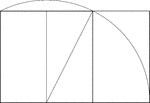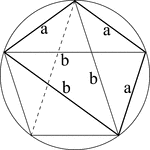Golden Mean
This mathematics ClipArt gallery offers 12 illustrations showing the Golden Mean, also known as the Golden Ratio, represented in different figures. The Golden ratio is approximately 1:1.618. Historically, it represents the proportion that most pleases the human eye. Philosophers, mathematicians, and artists have studied the Golden Mean.

Golden Angle
Illustration showing the golden angle. The golden angle is the smaller of two angles created by dividing…

Construction Of A Golden Rectangle
Illustration showing the construction of a golden rectangle. Beginning with a unit square, a line is…

Golden Ratio In A Pentagon
Illustration showing how the golden ratio in a regular pentagon (inscribed in a circle) can be found…

Golden Rectangle
Illustration showing the golden rectangle. Two quantities are considered to be in the golden ratio if…

Golden Rectangles
Illustration showing a nesting of 2 golden rectangles. Two quantities are considered to be in the golden…

Golden Rectangles
Illustration showing a nesting of 3 golden rectangles. Two quantities are considered to be in the golden…

Golden Rectangles
Illustration showing a nesting of 4 golden rectangles. Two quantities are considered to be in the golden…

Golden Rectangles
Illustration showing a nesting of 5 golden rectangles. Two quantities are considered to be in the golden…

Golden Rectangles
Illustration showing a nesting of 6 golden rectangles. Two quantities are considered to be in the golden…

Golden Rectangles
Illustration showing a nesting of 7 golden rectangles. Two quantities are considered to be in the golden…

Golden Rectangles
Illustration showing succession of golden rectangles that are used to construct the golden spiral. Two…

Golden Rectangles
Illustration showing succession of golden rectangles that are used to construct the golden spiral. Two…